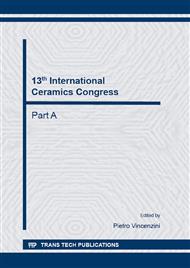[1]
B. L. Cushing, V. L. Kolisnichenko, and C. I. O'Connor, Recent advances in the liquid phase synthesis of inorganic nanoparticles. Chem. Rev. 104 (2004) 2893–3946.
Google Scholar
[2]
H. Mills and S. Blackburn, Zirconia toughened aluminas by hydrothermal processing. J. Eur. Ceram. Soc., 20 (2000) 1085–1090.
Google Scholar
[3]
O. Yamaguchi, M. Shirai, and M. Joskinaka, Formation and transformation of cubic ZrO2 solid solution in the system ZrO2-Al2O3. J. Amer. Ceram. Soc. 71 (1988) C510–C512.
DOI: 10.1111/j.1151-2916.1988.tb05821.x
Google Scholar
[4]
J. Chandradass, Myong Ho Kim, Dong-Sik Bae, Influence of citric acid to aluminium nitrate molar ratio on the combustion synthesis of alumina-zirconia nanopowders. J. Alloys and Comp. 470 (2009) L9–L12.
DOI: 10.1016/j.jallcom.2008.02.089
Google Scholar
[5]
S. Moreau, M. Gervais, A. Douy, Formation of metastable solid solution in the ZrO2-rich part of system ZrO2-Al2O3. Solid State Ionics 101–103, part 1 (1997) 625–631.
DOI: 10.1016/s0167-2738(97)84093-3
Google Scholar
[6]
M. M. Rashad, H. M. Baioumy, Effect of thermal treatment on the crystal structure and morphology of zirconia nanopowders produced by three different routes. J. Mat. Proc. Tech. 195 (2008) 178–185.
DOI: 10.1016/j.jmatprotec.2007.04.135
Google Scholar
[7]
J. Grabis, I. Steins, D. Jankovica, S. -P. Hannula, Nanosized Al2O3-ZrO2(Y2O3) nanopowders and their processing. In: World PM2010 Proceedings. Vol. 1. EPMA, 2010, 399–406.
Google Scholar
[8]
U. Popp, R. Herbig, G. Michel, Ch. Oestruch, Properties of nanocrystalline ceramic powders prepared by laser evaporation and recondensation. J. Eur. Ceram. Soc. 18 (1998) 1153–1160.
DOI: 10.1016/s0955-2219(98)00037-5
Google Scholar
[9]
J. L. Shi, Z. X. Lin, T. S. Yen, Effect of alumina restrains on the stability of tetragonal zirconia in alumina-zirconia composite powders. J. Eur. Ceram. Soc. 9 (1992) 27–33.
DOI: 10.1016/0955-2219(92)90073-m
Google Scholar
[10]
A. Rizzuti, C. Honelli, A. Corradi, E. Caponetti E., D. C. Martino, G. Narillo, M. L. Saladino, Structural characterization of zirconia nanoparticles prepared by microwave-hydrothermal synthesis, Dispersion Sci. Techn. 30 (2009) 1511–1516.
DOI: 10.1080/01932690903123676
Google Scholar
[11]
M. Descemond, C. Brodhag, F. Thevenot, B. Durand, M. Jebrouni, M. Roubin, Characteristics and sintering behavior of 3% Y2O3-ZrO2 powders synthesized by reaction in molten salts, J. Mater. Sci. 28 (1993) 2283–2288.
DOI: 10.1007/bf01151654
Google Scholar
[12]
J Grabis, D Jankovica, E Sokolova and I Steins, Characteristics of zirconia nanoparticles prepared by molten salts and microwave synthesis, IOP Conf. Series: Materials Science and Engineering 49 (2013) 012003.
DOI: 10.1088/1757-899x/49/1/012003
Google Scholar


